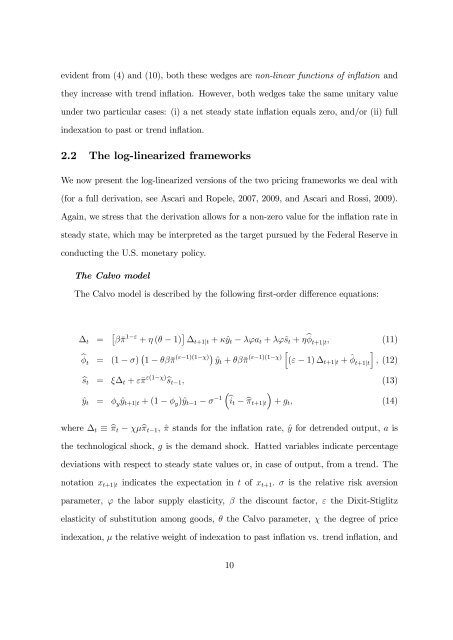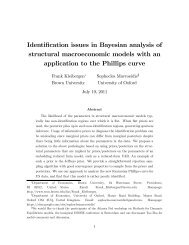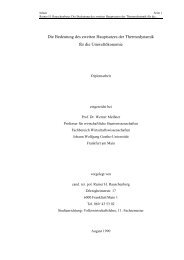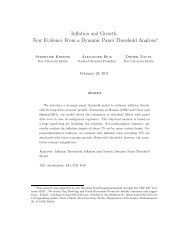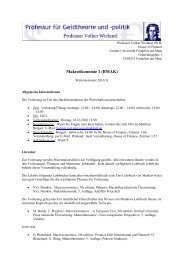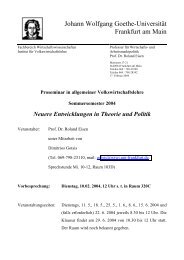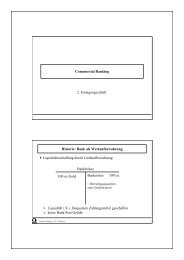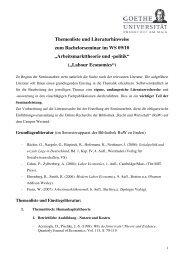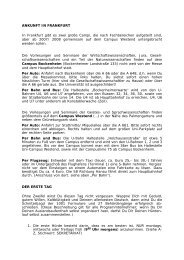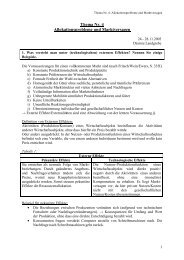Calvo vs. Rotemberg in a Trend Inflation World - Wiwi Uni-Frankfurt
Calvo vs. Rotemberg in a Trend Inflation World - Wiwi Uni-Frankfurt
Calvo vs. Rotemberg in a Trend Inflation World - Wiwi Uni-Frankfurt
Create successful ePaper yourself
Turn your PDF publications into a flip-book with our unique Google optimized e-Paper software.
evident from (4) and (10), both these wedges are non-l<strong>in</strong>ear functions of <strong>in</strong>‡ation and<br />
they <strong>in</strong>crease with trend <strong>in</strong>‡ation. However, both wedges take the same unitary value<br />
under two particular cases: (i) a net steady state <strong>in</strong>‡ation equals zero, and/or (ii) full<br />
<strong>in</strong>dexation to past or trend <strong>in</strong>‡ation.<br />
2.2 The log-l<strong>in</strong>earized frameworks<br />
We now present the log-l<strong>in</strong>earized versions of the two pric<strong>in</strong>g frameworks we deal with<br />
(for a full derivation, see Ascari and Ropele, 2007, 2009, and Ascari and Rossi, 2009).<br />
Aga<strong>in</strong>, we stress that the derivation allows for a non-zero value for the <strong>in</strong>‡ation rate <strong>in</strong><br />
steady state, which may be <strong>in</strong>terpreted as the target pursued by the Federal Reserve <strong>in</strong><br />
conduct<strong>in</strong>g the U.S. monetary policy.<br />
The <strong>Calvo</strong> model<br />
The <strong>Calvo</strong> model is described by the follow<strong>in</strong>g …rst-order di¤erence equations:<br />
1 "<br />
t = + ( 1) t+1jt + ^yt 'at + '^st + b t+1jt; (11)<br />
h<br />
b (" 1)(1 ) (" 1)(1 )<br />
t = (1 ) 1<br />
^yt +<br />
(" 1) t+1jt + ^ i<br />
t+1jt ; (12)<br />
bst = t + " "(1 ) bst 1; (13)<br />
^yt = y ^yt+1jt + (1 y)^yt 1<br />
1 bit bt+1jt + gt; (14)<br />
where t bt bt 1; ^ stands for the <strong>in</strong>‡ation rate, ^y for detrended output, a is<br />
the technological shock, g is the demand shock. Hatted variables <strong>in</strong>dicate percentage<br />
deviations with respect to steady state values or, <strong>in</strong> case of output, from a trend. The<br />
notation xt+1jt <strong>in</strong>dicates the expectation <strong>in</strong> t of xt+1: is the relative risk aversion<br />
parameter, ' the labor supply elasticity, the discount factor, " the Dixit-Stiglitz<br />
elasticity of substitution among goods, the <strong>Calvo</strong> parameter, the degree of price<br />
<strong>in</strong>dexation, the relative weight of <strong>in</strong>dexation to past <strong>in</strong>‡ation <strong>vs</strong>. trend <strong>in</strong>‡ation, and<br />
10


